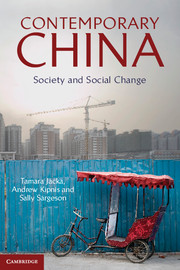Book contents
- Frontmatter
- Contents
- List of Images
- List of Maps
- List of Figures
- List of Tables
- Acknowledgments
- List of Abbreviations
- Map 0.1: China's provinces and provincial capitals
- Introduction
- Part 1 Social Institutions
- Part 2 Cultures, Socialization and the Formation of Identities
- Part 3 Inequalities, Injustices and Social Responses
- 10 Social Class and Stratification
- 11 Regional, Rural–Urban and Within-community Inequalities
- 12 The “Woman Question” and Gender Inequalities
- 13 Collective Action and Social Change
- Glossary of Chinese Terms
- References
- Index
10 - Social Class and Stratification
Published online by Cambridge University Press: 05 June 2014
- Frontmatter
- Contents
- List of Images
- List of Maps
- List of Figures
- List of Tables
- Acknowledgments
- List of Abbreviations
- Map 0.1: China's provinces and provincial capitals
- Introduction
- Part 1 Social Institutions
- Part 2 Cultures, Socialization and the Formation of Identities
- Part 3 Inequalities, Injustices and Social Responses
- 10 Social Class and Stratification
- 11 Regional, Rural–Urban and Within-community Inequalities
- 12 The “Woman Question” and Gender Inequalities
- 13 Collective Action and Social Change
- Glossary of Chinese Terms
- References
- Index
Summary
In the 1970s,China was considered a comparatively egalitarian society, in which class designation and the rural–urban divide constituted the main sources of social and material inequality. In 2010, there were more than a million millionaires in the country, and Forbes magazine listed 64 Chinese citizens among the world's richest billionaires. At the other end of the spectrum, the Chinese government, the United Nations Development Program (UNDP) and the World Bank estimated that between 120 and 150 million Chinese were living on less than US$1.25 (purchasing power parity) per day. Rarely do Chinese citizens speak of this wealth gap in the vocabulary of class. Indeed, other than the term “middle class”, the word is not commonly used. And, although inequalities are obviously increasing, wealth is no longer confined to urban areas and poverty is not exclusive to the countryside.
Why, and how, have explanations and indicators of material and social polarization changed so dramatically in China? What are the key axes of polarization, and what are the direction and tempo of trends in inequality? How do people view their relative position in this rapidly changing social order?
Conceptualizing stratification and class in China: historical perspectives
The terms “class” and “stratification” are quintessentially ideological. That is, they encapsulate ideas, beliefs and values about the sources and conditions of inequality, and the principles and structures characterizing relations in an ideal society, as well as efforts to normalize certain experiences of inequality and maintain or transform relations of inequality.
- Type
- Chapter
- Information
- Contemporary ChinaSociety and Social Change, pp. 199 - 216Publisher: Cambridge University PressPrint publication year: 2013



